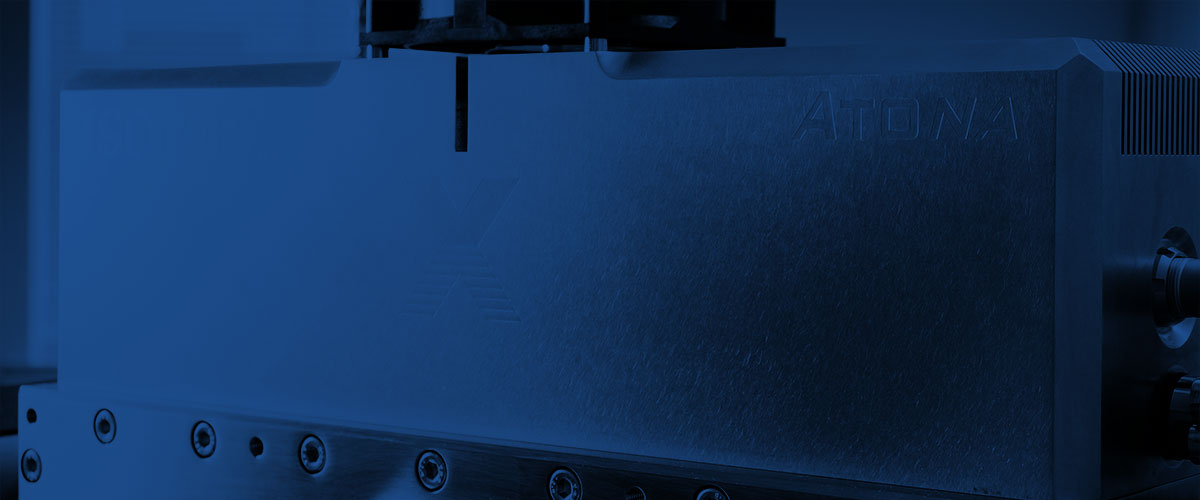
TIMS
Phoenix
Thermal Ionization Mass Spectrometer
Features and Benefits
- Patented high dynamic range ATONA® Faraday amplifiers
- 9 individually motorized long-life Faraday cups
- Up to 10 individually motorized ion counting detectors
- ZEPTONA Faraday with noise performance better than a theoretical 1e14 ohm resistor
- Proven Daly detector with ultimate linearity through its dynamic range of 1 to millions of cps
- Extended geometry for simultaneous measurement of UO2 +


ATONA® amplification means lower noise, larger dynamic range and easier set-up for ultimate instrument flexibility and measurement precision
Product Description
The Phoenix TIMS combines our proven source design and optics with newly developed detector technologies to produce the highest precision data. The Phoenix is completely customizable to suit the needs of your lab now and future-proofing your lab for new applications.
The Phoenix TIMS (thermal ionization mass spectrometer) is designed to measure isotope ratios of non-gaseous elements with the highest sensitivity and precision. Careful design of the ion extraction optics combined with high vacuum around the ionizing filament results in a highly sensitive instrument, while low-noise, stable detectors that measure extremely low ion currents maximize precision. The Phoenix represents the ultimate combination of all these factors, giving you the breadth of analytical capabilities that you need.
ATONA®
The unique, patented ATONA (aA to nA) amplification technology from Isotopx has eliminated the need for a feedback resistor. The outcome is a significant reduction in amplifier noise, a dramatic increase in dynamic range, rapid amplifier decay, and improved baseline and calibration stability. But what does this mean for your analysis?
In practice, this means analysis of signal sizes from tens of counts per second to nanoamps (hundreds of volts) with lower noise than any resistor-based amplifier. So you can analyze a wider range of sample sizes than ever before, with more confidence in your data.

Software
The new Isolinx software is a fresh take on traditional mass spectrometry software. It is clearly laid out and intuitive and has been designed to make instrument control and data acquisition as simple and productive as possible.
Software features
- Built from the ground up using the latest developer technologies and fully compatible with the latest version of Windows
- Single PC instrument operation (no embedded PC)
- Improved sample management tools including: dedicated name editor, filament type, bead status indicator and information import via `QR’ barcode reader
- Advanced instrument control with: mass scanning/time acquisition modes, mass/intensity markers, IsoMarkers, variable zoom feature, calibration/profiling tools, safety features, and ionmode reversal assistant
- New peak centre control panel. Peak scanning method using highly advanced algorithms to detect peaks at the 1mV level – with real-time manual over-ride option
- USB Pyrometer support to 0.1ᵒC resolution
- Intuitive analysis method construction
- Dynamic task-based sample preparation methodology. Easy configuration and real-time parameter modification for fully automated analysis runs
- Significantly improved beam management with flexible filament control and powerful Total Flash Evaporation (TFE) facility
- Comprehensive sample run event logging
- Real-time and post processing of analysis data
- Raw data stored in open-source SQLite database files. Export of raw and processed data in machine-readable ASCII files.

Upgrades
ATONA® Upgrade
Phoenix TIMS instruments can be upgraded to ATONA®, adding improving instrument flexibility and future-proofing it for potential new applications. Get in touch about upgrading your instrument.

ZEPTONA Upgrade
The Zeptona system comprises a custom-designed single Faraday detector mounted behind the main multicollector of the Phoenix TIMS, fitted with an ATONA® amplifier. This combination provides an ultra-low noise, low drift, high-dynamic-range Faraday collector that can be used in conjunction with the main ATONA® Faraday collectors, improving the opportunities for low-abundance analysis.

Isolinx Software Upgrade
Isotopx new Isolinx software is a completely new software suite which has been designed to make instrument control and data acquisition as simple and productive as possible. This software is compatible with the latest versions of Windows and is regularly updated with feedback from engineers and customers. Contact us below to find out if your instrument could benefit from a software upgrade.

Resources
-
Measurement of osmium isotopes using Isotopx ATONA Faradays
How small an ion beam can ATONA® ultra-low noise Faraday collectors measure and still get useful data? Faraday collectors and ion counting collectors are both excellent analytical tools. The former are typically used for larger ion beam sizes, the latter for smaller ion beam sizes. They have their own positive and negative features. Intercalibration between…
-
Measurement of 234U/238U in IRMM184 uranium standard using the Isotopx ATONA and Zeptona Faraday detector systems
Zenon Palacz, Shaun Yardley, Matt Hockley, Steve Guilfoyle Introduction High precision determination of 234U / 238U is important in many geological research applications. The typically low abundance of 234U (234U / 238U = 0.000053196 in IRMM184) in these applications has necessitated the use of ion counters for this isotope, while the much larger 238U must…
-
Zeptona: Ultra-low noise amplifier technology
You may already know about ATONA® technology. Zeptona takes it one step further. Resistor-based Faraday detectors have a limited overlap of dynamic range with ion counting detectors, and even other Faradays when using different feedback resistors. If the beam intensity is too low then the Faraday noise reduces your precision. It it’s too high then…
-
Precise measurement of trace actinides
using Phoenix TIMSZenon Palacz, Shaun Yardley, Matt Hockley, Steve Guilfoyle What is this study about? The performance characteristics of an Isotopx Phoenix equipped with 10 conversion dynode ion counters with newly developed MICX electronics is evaluated. This design allows the simultaneous measurement of actinides at unit mass spacing. The ion counters are independently movable allowing the study…
-
ATONA: world class amplifier technology
What if you had Faraday amplifiers that gave you the low noise level of 1e13 Ω amplifiers, yet you could also put huge ion beams on them – without consequence? What if these amplifiers had almost zero resistor lag or Tau decay time? What if these amplifiers were so stable that gain calibrations could almost…
-
Optimising ATONA integration times for beam intensity
Application note AN22_01 Matt Hockley, Isotopx Ltd, Dalton House, Dalton Way, Middlewich, Cheshire, CW10 0HU, UK. How do I select an integration time to optimise my measurement precision? Introduction When measuring an ion beam, there are two sources of uncertainty on the measurement: uncertainty due to amplifier noise, and uncertainty due to the shot noise…
-
Introducing ATONA for TIMS – A paradigm shift in signal amplifier technology
Technical Note T30182 Isotopx Ltd, Dalton House, Dalton Way, Middlewich, Cheshire, CW10 0HU, UK. Introduction Over the past 20 years improvements in resistor amplification technology have slowed. The marginal gains that have been made are largely offset by the practical limitations. The newly developed ATONA (aA to nA) amplification technology from Isotopx has eliminated the…
-
Ultra Low Noise and Baseline Drift Zeptona Faraday Detector
Technical Note 2102 Matt Hockley, Zenon Palacz, Shaun Yardley and Tony Jones, Isotopx Ltd, Middlewich, Cheshire, UK. Introduction The recently developed Isotopx ATONA® Faraday amplifier represents the benchmark in ion beam signal measurement using Faraday collectors1. A further advance; the Zeptona detector system is presented in this technical note. The Zeptona system comprises a custom…
-
Isotopic analysis of sub-nanogram Nd standards using new ATONA amplifiers
Andrew A. Reinhard 1, Jeremy D. Inglis1, Robert E. Steiner1, Stephen LaMont1, Matthew G. Jackson2 1Nuclear and Radiochemistry, Los Alamos National Laboratory 2Department of Earth Science, University of California Santa Barbara Motivation In the last several years new amplifier technologies have been released for thermal ionization mass spectrometers (TIMS) including the ATONA amplifiers produced by…
-
Ultra Low Noise Multiple Isotopx Ion Counting (IIC) and Faraday Detectors on Phoenix TIMS
Technical Note 2101 Matt Hockley, Zenon Palacz, Shaun Yardley and Tony Jones, Isotopx Ltd, Middlewich, Cheshire, UK. Introduction When measuring very small ion signals (<10,000cps), in sub picogram samples of actinides, ion counting detectors are necessary due to their low noise compared to that of a Faraday detector. Ion counters however, still have a nonzero…
-
Phoenix – Thermal Ionization Mass Spectrometer
World class heritage and knowledge. Isotopx are the TIMS specialists. Isotopx was formed in February 2008 as a Management buyout (MBO) from GV instruments. The BO was in response to Thermo Corporation’s purchase of GV instruments and the subsequent enquiry by the UK Competition Commission into the purchase. We trace our heritage to the very…
-
U-Pb TIMS Geochronology using ATONA® Amplifiers
Dawid Szymanowski & Blair Schoene Department of Geosciences, Princeton University; dszymanowski@princeton.edu; bschoene@princeton.edu V11D-0124 Key Points ATONA [aA (10-18 A) to nA (10-9 A)] is a new Faraday cup signal amplifying technology for Isotopx Phoenix thermal ionisation mass spectrometers (TIMS) Main advantages for TIMS U–Pb geochronology (compared to conventional ion counting with peak-hopping): Better precision and…
-
An assessment of the linearity of the ion-counting Daly detector and Hamamatsu photomultiplier using NBS U500
The Daly detector was designed by N.R Daly in the 1960’s . The design uses a conversion dynode to convert incident ions into electrons. It also separates the multiplication electronics away from the ion beam preventing secondary ion production on the multiplication dynodes. The conversion surface is a highly polished, aluminised metal surface that is…
-
Total evaporation analysis (TE) of 500ng loads of U500 using Phoenix TIMS – Precision and Efficiency.
Introduction Uranium does not have a stable isotope pair that can be used to correct for mass fractionation in a TIMS. Measurements have to be made using external mass fractionation control or by total evaporation of the sample and simultaneous (static) collection of all isotopes. Addition of a doubly enriched isotope spike e.g. 233U and…
-
Phoenix Service Agreement Options
-
High precision isotope ratio measurements of Sr and Nd at the nanogram level using the Phoenix TIMS with next generation Faraday detectors
Zenon Palacz What are the parameters required for high precision measurements of small samples? (on Faraday collectors) High Sensitivity Instrument sensitivity Use of activators Low noise Close to theoretical Johnson noise Baseline stability Gain stability between detectors Required for static analyses Multidynamic measurements: Eliminates gain and efficiencies But can it be used on small samples?…
-
Phoenix Site Planning Guide
The purpose of this site planning guide is to provide users with specific information regarding the instrument requirements to allow adequate site preparation. This site planning guide will enable our users to prepare their laboratory with the necessary services and minimise any possible delays. The Phoenix TIMS is a high precision electronic instrument whose performance…
-
Selected Bibliography of Peer-reviewed Publications
This bibliography provides a list of selected recent publications in which Isotopx TIMS instruments were used to generate analytical data. The first revision of the Isotopx bibliography was released in April 2012 and proved extremely popular with over 100 website downloads (it was the second most popular download after the Phoenix brochure). Of course, literature…
-
Abundance Sensitivity of the Phoenix and Phoenix X62 TIMS
Zenon Palacz, IsotopX Ltd, Middlewich, Cheshire, UK. Introduction Abundance sensitivity is a measure of the contribution of the peak ‘tail’ of a major isotope on an adjacent minor isotope. The tailing is due to the collision of ions with residual gas molecules in the mass spectrometer causing a loss of ion energy. This is manifest…
-
Evaluation of the stability of multiple ion counting detectors on Phoenix TIMS
Zenon Palacz, Isotopx Ltd, Middlewich, Cheshire, UK Introduction For the measurement of isotope ratios in nanogram to picogram sized samples of uranium and plutonium, an ion counting detector is used. However, when measuring a series of isotopes, any individual isotope may only be detected for a fraction of an individual analysis cycle. This will reduce…

Contact one of our experts today to find out how Phoenix could better enable your isotope ratio measurements